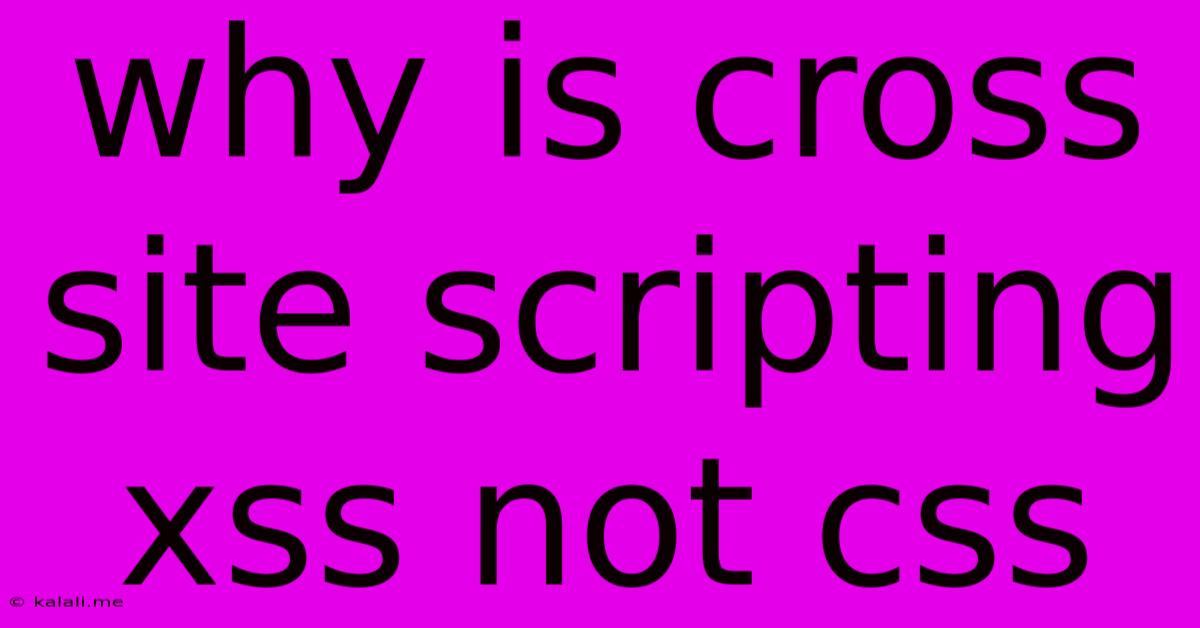Why Is Cross Site Scripting Xss Not Css
Kalali
May 23, 2025 · 3 min read

Table of Contents
Why is Cross-Site Scripting (XSS) Not CSS? A Clear Explanation
Cross-Site Scripting (XSS) and Cascading Style Sheets (CSS) are two entirely different concepts in web development, often confused due to their similar-sounding acronyms. This article will clearly delineate the differences, explaining why XSS is absolutely not CSS and highlighting the security implications of XSS vulnerabilities.
Understanding Cross-Site Scripting (XSS)
XSS is a serious web security vulnerability that allows attackers to inject malicious scripts into websites viewed by other users. These scripts can steal sensitive information like cookies, session tokens, or credit card details, redirect users to phishing sites, or deface websites. The core of XSS lies in the ability of an attacker to insert client-side code (JavaScript, primarily) into a website's content, which then executes in the victim's browser. This often happens when user-supplied data isn't properly sanitized before being displayed on a webpage. Think of it as a malicious code injection attack targeting the client-side. Key characteristics include:
- Client-Side Attack: XSS exploits occur within the user's browser, not on the server.
- Injection of Malicious Code: Attackers inject scripts, typically JavaScript, to perform harmful actions.
- User Context Execution: The injected script runs within the context of the victim's browser, granting the attacker access to their session and data.
- Data Theft and Manipulation: The primary goals are stealing information, redirecting users, and manipulating the webpage's behavior.
Understanding Cascading Style Sheets (CSS)
CSS, on the other hand, is a stylesheet language used to style HTML and XML documents. It controls the visual presentation of web pages, dictating aspects like:
- Fonts: Font family, size, color, etc.
- Colors: Background colors, text colors, etc.
- Layout: Positioning elements, margins, padding, etc.
- Responsiveness: Adapting the layout to different screen sizes.
CSS is fundamentally a styling mechanism. It's a declarative language that describes how the content should look, not what the content is or what it does. It poses no inherent security risk on its own. It's purely about presentation and user interface.
The Crucial Difference: Functionality vs. Presentation
The critical distinction lies in their functionality. CSS is about styling and presentation; XSS is about malicious code execution. CSS does not execute code; it only defines how existing content is displayed. XSS, however, injects code that executes within the user's browser, potentially causing significant harm. Confusing the two is a fundamental misunderstanding of web security principles.
Mitigation Strategies for XSS
Protecting against XSS involves several strategies, including:
- Input Validation and Sanitization: Thoroughly validating and sanitizing all user-supplied data before it's used in the application. This is crucial to prevent malicious scripts from being injected.
- Output Encoding: Encoding data before displaying it on the webpage, converting special characters into their HTML entities to prevent their interpretation as code.
- Content Security Policy (CSP): Implementing a CSP to control the resources the browser is allowed to load, reducing the risk of loading malicious scripts from untrusted sources.
- HTTP-only Cookies: Setting the
HttpOnlyflag on cookies to prevent client-side JavaScript from accessing them.
In conclusion, XSS and CSS are completely different concepts. While both deal with web pages, XSS is a critical security vulnerability that allows attackers to inject malicious code, while CSS simply controls the presentation of content. Understanding this distinction is essential for building secure and robust web applications.
Latest Posts
Latest Posts
-
30 X 30 Is How Many Square Feet
Jul 12, 2025
-
How Much Does A Half Oz Weigh
Jul 12, 2025
-
Calories In An Omelette With 3 Eggs
Jul 12, 2025
-
How Do You Say Great Grandmother In Spanish
Jul 12, 2025
-
What Is 873 Rounded To The Nearest Hundred
Jul 12, 2025
Related Post
Thank you for visiting our website which covers about Why Is Cross Site Scripting Xss Not Css . We hope the information provided has been useful to you. Feel free to contact us if you have any questions or need further assistance. See you next time and don't miss to bookmark.